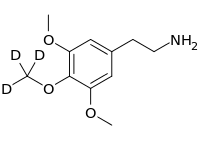 | |
| Names | |
|---|---|
| IUPAC name 3,5-Methoxy-4-trideuteromethoxyphenethylamine | |
| Identifiers | |
3D model (JSmol) | |
| ChemSpider | |
| |
SMILES
| |
| Properties | |
| C11H14NO3D3 | |
| Molar mass | 228.28 g/mol |
Except where otherwise noted, data are given for materials in their standard state (at 25 °C [77 °F], 100 kPa). | |
4-D (3,5-methoxy-4-trideuteromethoxyphenethylamine) is a lesser-known recreational psychedelic drug. It is one of the few drugs that bears deuterium. It is a deuterated analog of mescaline. It may be prepared either as a sulfate salt or a hydrochloride salt. 4-D was first synthesized by Alexander Shulgin. In his book PiHKAL, the dosage is listed as approximately 200–400 mg for the sulfate salt, and 178–356 mg for the hydrochloride salt. 4-D lasts for approximately 12 hours. It causes closed-eye visuals, mild open-eye visuals, color distortion, and mydriasis.[1] Very little data exists about the pharmacological properties, metabolism, and toxicity of 4-D.
See also
- beta-D, another deuterated phenethylamine
References
- ^ Shulgin, Alexander; Shulgin, Ann (September 1991). PiHKAL: A Chemical Love Story. Berkeley, California: Transform Press. ISBN 0-9630096-0-5. OCLC 25627628.